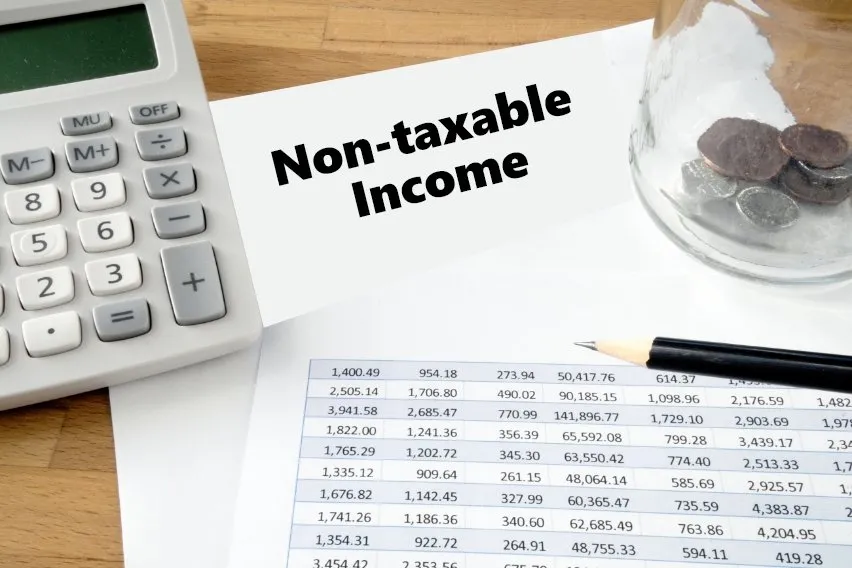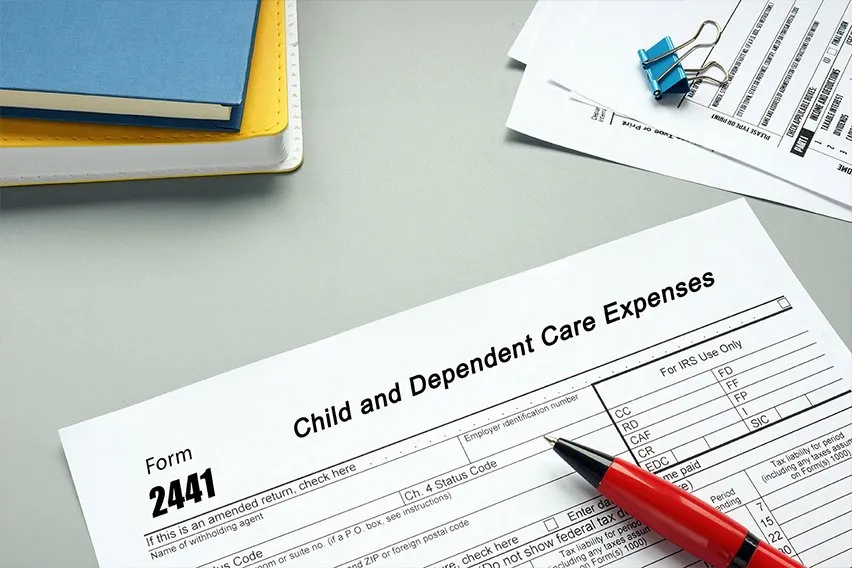Top 12 Non-taxable Income Types

Even though most of the income you earn from your job or investments is subject to income tax, some types are completely tax-free. Non-taxable income types vary, and you may encounter them during your life while filing taxes. But don’t worry—while the IRS collects taxes from everyone, these funds stay safe.
Keep reading to learn about what non-taxable income is and the various types.
Table of Contents
What Is Non-taxable Income?
Non-taxable income is income that the Internal Revenue Service (IRS) deems not subject to tax. Even if you write it on your tax return, the government won’t tax it. You pay taxes for almost everything you do. But these types of income are all tax-exempt, meaning you get 100% of the stated amount unless there are other fees.
These other fees may be state or local taxes, for example. But this doesn’t apply to everyone in the United States.
It’s interesting to note that there are states that don’t charge a state income tax at all. These include the following:
- Alaska
- Florida
- Nevada
- New Hampshire
- South Dakota
- Tennessee
- Texas
- Washington
- Wyoming
You still pay taxes in these states, as there are plenty of other taxes. For example, you always owe federal tax. Some localities have their own taxes as well. And the loss of state tax revenue is often recouped through higher property taxes or other taxes.
Taxable and non-taxable income can come from the same source. However, fulfilling conditions may result in the former becoming the latter. Confusing, huh? Sometimes it’s best to consult a tax professional if you’re unsure. You should also check how much can you make without filing taxes.

Types of Non-taxable Income
Here are the 12 types of non-taxable income. They’re not all necessarily tax-free in every circumstance, but you should always keep these in mind. Also, all of these aren’t included in federal taxes—except in rare situations.
Accelerated Death Benefits
Accelerated death benefits (ADB) attach to a life insurance policy. It allows the holder to receive cash advances after a diagnosis of a terminal disease. Typically, the life insurance policyholder uses the money to make their life as comfortable as possible before they pass away.
The ADB’s conditions usually consist of a terminal diagnosis that leaves the policyholder with around 2 years to live. You also qualify if you require an organ transplant, extended hospice care, or assistance with daily activities.
Some life insurance companies include ADB. Others will require the insured person to pay a fee or percentage of an existing death benefit.
Child Support
Child support payments aren’t considered taxable income. Therefore, they usually aren’t included on your income tax return. However, there are some rare exceptions.
Divorce or separation instruments executed on or before December 31, 2018, are taxable to the recipient. In other words, if you filed for divorce or separation before that date, the payments are not tax-free.
Some of these instruments may see changes after December 31, 2018. And these changes may result in the child support payments being tax-free. Otherwise, every instrument filed after that date is tax-free income.
If your separation is more recent, there’s probably no need to worry about whether the child support received is taxable or non-taxable. You get to keep the full amount from the payer.
Disability Insurance Payments
Generally, disability benefits are tax-free if you bought a policy with after-tax dollars. This measure prevents individuals from getting taxed twice. These benefits don’t replace your main source of income.
Disability insurance payments are only taxable if an employer pays for all or part of the insurance premium. Those who pay with pre-tax dollars must pay taxes.
You may buy the policy you purchase with after-tax dollars through an employer or from a private insurance provider.
Workers’ compensation and non-punitive damage compensation also fall under this category. Other benefits include those from a public welfare fund or receiving an amount under a no-fault car insurance policy. This last benefit type can be for either income loss or losing earning capacity due to sustaining injuries.
Disaster Relief Assistance
The Internal Revenue Service states that disaster relief payments are tax-free. That is, unless an insurance policy or some other form of reimbursement pays for the expense. Below are some qualified government payments:
- Expenses for disaster-related difficulties, including medical expenses, funerals, and transportation needs.
- Expenses used in repairing a residence damaged by a presidentially declared disaster.
- Costs for replacing personal belongings within a home damaged by a disaster.
All 3 of these instances of disaster relief assistance are only paid if they are within reason and deemed necessary by the government. Casualty losses aren’t deductible income, meaning you still need to include it in your gross income tax.
Employer-provided Insurance
One of the most popular benefits offered by employers is group-term life insurance. The first $50,000 of this coverage, no matter if it’s carried directly or indirectly by an employer, is tax-free. However, if you get more than $50,000, you must include the amount as part of your income tax.
Amounts more than $50,000 are subject to Social Security and Medicare taxes. One adds this using the IRS Premium Table.
A policy is “directly carried” by the employer if they pay for even a small part of the plan. This is also true if they arrange for premium payments. In this case, the premiums paid by 1 or more employees also subsidize those paid by at least 1 other employee. We call this the “straddle rule.”
There are no tax consequences if the employer-provided insurance doesn’t go beyond $50,000.
Financial Gifts
Any financial gift you give to another person without receiving something in return that’s at least of equal value is tax-free income. However, there is a limit to the gift tax exclusion. It’s $18,000 in 2024, while it was $17,000 in 2023.
Most taxpayers won’t ever have to pay gift taxes because there’s a lifetime gift limit of $13.61 million as of 2024. If you pay $200,000 to a family member, the Internal Revenue Service will deduct it from your lifetime exemption. This is calculated assuming you didn’t give any other gifts surpassing the annual limit.
The federal gift tax ranges from 18-40%, and it depends on the gift’s size.
These financial gifts can be one of the following:
- Cash
- Checks
- Property
- Interest-free loans
- Anything sold below fair market value
Note that gifts meant to support a person’s education can only go towards paying off college tuition. It can’t be textbooks or meal plans.
Illness and Injury Benefits
Some illness or injury benefits are non-taxable income. Here is a brief list:
- Compensation for a personal physical injury
- Black lung benefits
- Qualified Indian benefits received after March 23, 2010
- Workers’ compensation payments paid under a workers’ compensation act
Inheritance
On the federal level, inheritances aren’t considered income at all. It doesn’t matter if you receive cash, property, or investments from someone who named you as the successor. However, an asset produces income if you use it in your financial endeavors.
You must report interest income from inherited cash and stocks to the Internal Revenue Service unless it’s from a tax-free source.
An estate that exceeds a certain size may require owners to pay estate taxes. There is a federal estate tax exemption of up to $13,610,000 in 2024, and the amount generally rises due to inflation. Any amount under that is tax-free income.
There is no federal inheritance tax. Note that some states have mandatory estate taxes:
- Connecticut
- Hawaii
- Maine
- Maryland
- Massachusetts
- Minnesota
- Illinois
- New York
- Oregon
- Rhode Island
- Vermont
- Washington
- Washington, D.C.
6 states have inheritance taxes. They are:
- Iowa
- Nebraska
- Kentucky
- New Jersey
- Pennsylvania
- Maryland
Maryland is the only state that has both an inheritance and an estate tax.
Life Insurance Payouts
Life insurance payouts left to you by a loved one who passed away are generally tax-free, with some exceptions.
Most cases allow beneficiaries to leave these out of gross income. But any interest from these life insurance proceeds is taxable. You should report it as interest received to the Internal Revenue Service.
Municipal Bond Interest
Typically, anyone who invests in bonds must report investment income to the Internal Revenue Service. One notable oddity is municipal bonds issued by your state or a government entity. These generate tax-free income federally, while the same also applies to the state or local levels that issued bonds.
These entities issue municipal bonds to fund public works, and the issuer promises to pay an investor interest for a time. Once the bond matures, the investor gets their principal back.
These municipal bonds come in 2 types: general obligation and revenue bonds. General obligation bonds support public projects not linked to revenue streams. Revenue bonds finance projects slated to generate revenue.
Roth IRA Income
Roth individual retirement accounts consist of after-tax income. The earned income in these accounts is generally tax-free if you are within some general guidelines:
- A distribution occurs 5 years after the account owner establishes and first contributes to their IRA
- The holder is at least 59.5 years old
- The holder is disabled
- A beneficiary will receive the assets after the owner passes away
- The distributed assets help to buy, construct, or rebuild the holder’s or a qualified family member’s first home, with a limit of $10,000 per lifetime
Only the first and 1 of the 4 subsequent rules need to apply for withdrawals to be taxable. These rules apply to Roth IRAs, Roth 403(b)s, and Roth 401(k)s.
Unqualified distributions are subject to taxes based on the Roth IRA assets and IRS tax rules.
Sale of a Principal Residence
Selling your home and making a profit is always a great thing. However, the yield is usually subject to capital gains tax. You can exclude up to $250,000 or $500,000 from taxation if you’re a single or married joint filer, respectively.
This exemption is only claimable once every 2 years. The federal government must see proof of you living in the house.
You still owe tax, but the total capital gains tax you have to pay is much less than before. Your personal finance records will thank you.
Even so, the filer must own the home and have lived in it for at least 2 of the past 5 years before the sale. The 2 years don’t have to be consecutive as long as you have lived in the home for 24 months within the past 5 years.

Key Takeaways
Not all income is taxable. There are at least 12 types of non-taxable income available in the United States, and you may receive this money in full, or it may be subject to other fees. The federal government usually won’t require you to list it on your return. Non-taxable income is excellent for your personal finances.
Each of these 12 types of income has its own conditions and exceptions. So, you’re advised to contact a trained professional if you have questions. If you think a source of income may be tax-exempt but encounter difficulties, always ask more questions.
FAQ on Non-taxable Income
What Is the Limit for Non-taxable Income?
There isn’t a clear limit on how much non-taxable income you can earn in a year. However, different benefits may have limits, so be sure to check their laws.
What Is Non-taxable Earnings on a W2?
On your W2, you may have earned income that is not subject to taxes if you meet certain conditions, such as life insurance and healthcare benefits. You don’t need to declare it to the IRS when filing your tax return. Consult a tax professional if you’re unsure.
What Is the Difference Between Taxable Income and Non-taxable Income?
Taxable income is subject to taxes under federal law. Non-taxable income can’t be taxed by the federal government unless there are exceptions.
Which Part of Salary is Non-taxable?
One of the non-taxable parts of your salary payments is insurance. Most of the rest of your salary is taxable.
RELATED ARTICLES

 Veteran Tax Benefits: The Ultimate Tax Guide
Veteran Tax Benefits: The Ultimate Tax Guide What is a Sales Tax License & How to Apply For It?
What is a Sales Tax License & How to Apply For It? Why Would a Vendor Request a W9 Form?
Why Would a Vendor Request a W9 Form? List of Common Tax Deductions for Owner Operator Truck Drivers
List of Common Tax Deductions for Owner Operator Truck Drivers What Are IRS Meal Allowances Per Diem Rates for Tax Payers
What Are IRS Meal Allowances Per Diem Rates for Tax Payers What’s a Dependent? Definition & Tax Tips
What’s a Dependent? Definition & Tax Tips